Yoga: Modern Western Paintings of Japan (日本近代洋畫大展) is a comprehensive show of Japanese modern paintings that date from the Meiji to Showa period (late 19th century to early 20th century). The show includes over 80 paintings by 31 artists who contributed to the early blossoming of western painting in Japan, including artist and educator Kuroda Seiki, the founding director of the Western Painting Department of Tokyo University of the Arts. Kuroda and his colleague Kume Keiichiro studied in France under French painter Raphael Collin. After returning to Japan, they set up a school to teach western art theories to a wider audience. Kuroda and Kume shared Collin’s interests in developing techniques of illumination. In Kuroda’s Woman (in the kitchen), a modest women in a solemn dress is seated in her kitchen; the scene is depicted with varying white tones to express subtle nuances of light and air. The show features the influences of many European trends, including cubism, fauvism, surrealism, and plein air painting. Also on view are Yorozu Tetsugoro’s ‘Nude’ which renders a female figure with bold strokes and abstracted forms; and the works of Ishikawa Kinichiro, an important figure to the first wave of western painting in Taiwan during the Japanese colonial period.
■ Museum of National Taipei University of Education (北師美術館) 134, Section 2, Heping E Rd, Taipei City (台北市和平東路2段134號) , tel: (02) 6639 6688. Opens Tuesdays to Sundays from 10am to 5pm
■ Through Jan. 7
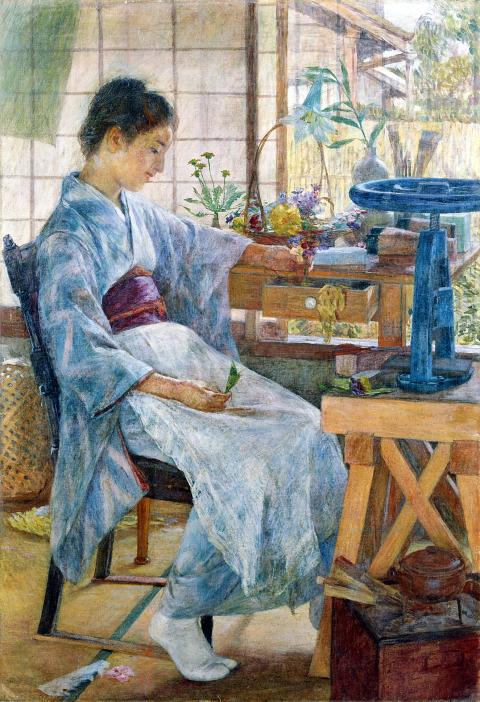
Photo Courtesy of the Museum of National Taipei University of Education
Chinese artist Zhao Zhao (趙趙) is known for his provocative reflections on contemporary China through a variety of mediums. His current solo exhibition, Self Portrait (自畫像), appears to be relatively subdued; yet underneath its quiet surface, the act of repeatedly painting pictures of himself over an intense period suggests an act of interrogating the idea of ones self image — both in today’s society and in painting history. The show features 36 self-portraits created over the past two years, in which Zhao consistently maintains the same angle and posture with his chin propped up by his left hand and his eyes staring into the distance. Zhao paints with varying treatment of the material surface; a few portraits appear to be quick sketches with bold strokes and big areas of washes; while others are more labored over, decoratively etched out with the brush bristles or colored over with multiple layers. “To Zhao, a self portrait is not a traditional method of capturing the moment… of affirming oneself through expression…,” writes Chinese curator Cui Cancan (崔燦燦). Presented together, each of the 36 portraits struggles to maintain its legitimacy as a defined entity distinct from the other iterations of the self.
■ Lin & Lin Gallery (大未來林舍畫廊) 1F, 16, Dongfeng St, Taipei City (台北市東豐街16號1樓), tel: (02) 2700 6866. Opens Tuesdays to Sundays from 11am to 7pm
■ Through Jan. 14

Photo Courtesy of The Place, Tainan
Experience The City (行旅II) is a group exhibition that features three art projects inspired by the city of Tainan. The exhibition is at The Place, a hotel in Tainan, and occupies an open area on three consecutive residential floors. This refreshing arrangement seems to draw art closer to public life while also highlighting the cultural insights that artists may offer to visitors of the city. The show begins with NDD Design’s (唐草設計) theatrical installation of caricatured street vending trucks that draw from the aesthetic of local street food culture. The vending stations provide special cuisine tips and guides for food walks around town. On the floor above, Chu Yin-hua’s (朱盈樺) Encoding Memories: Tainan shares a collection of stories about Tainan food and local culture. These stories are presented as slides that visitors may flip through with toy slide viewers. Tingshuo’s (聽說) Gentle Steps Listening Walks offers four listening stations of beautifully composed soundscapes recorded from different districts in Tainan. Each station also includes a map of where each soundtrack took place, creating an imaginative guide to people and stories that have occurred around town.
■ Tainan The Place (老爺行旅) 368, Zhonghua E Rd Sec 1, Tainan City (台南市中華東路一段368號), tel: (06) 236 6168. Please contact hotel for gallery opening hours.
■ Through Feb. 28
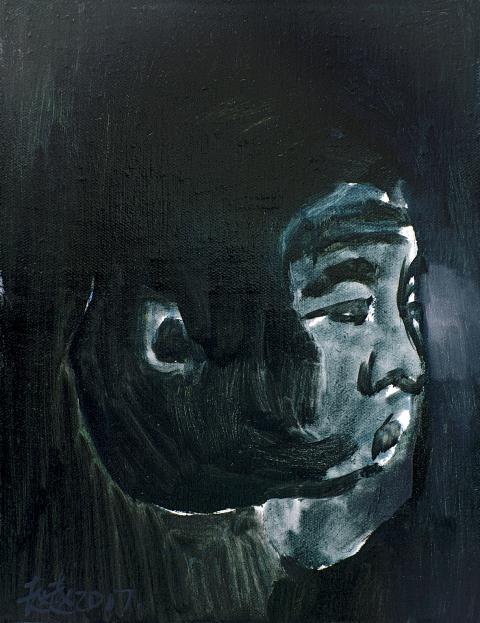
Photo Courtesy of Lin & Lin Gallery
The Ocean Debris Photography Project by Taiwan-based collective One One & One creates intriguing still life photographs of discarded objects that have been tossed in the ocean and washed back to shore after a period of time. The twisted rubber sole of a shoe, a bent plastic ruler, and a flattened drink bottle are among 111 artifacts that the team collected from Hualian County’s Chihsingtan Beach (七星潭海邊). Chihsingtan Beach offers scenic ocean views, but is also contaminated with garbage, much of which has been eroded by the sea. “The process is almost like we toss something into the ocean, and she gives us back a work of art,” says the team. The photos of these artifacts capture in close detail the washed out colors and distorted shapes of artificial products manipulated by the organic force of the sea. While marveling at the wonders of ocean craft, the team also helps clean up the coast during its documentation process. Hi! We Are Back features the project’s photographs and collected objects.
■ Intzuition (以覺學金工實驗室), 23, Ln 19, Liaoning St, Taipei City (台北市遼寧街19巷23號), tel: 0909 331 521, Opens Wednesdays to Mondays from 11am to 7pm
■ Through Dec. 17
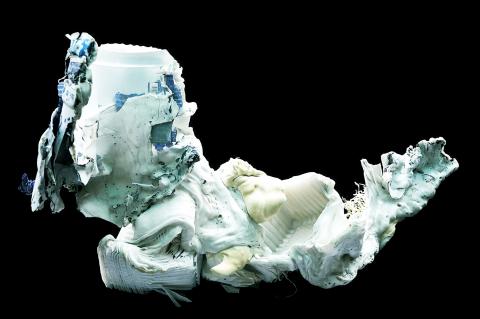
Photo Courtesy of the artist
Since 2015, Chang San-hsueh (張善學) has been creating monochromatic still lifes of blankets, pillows and sheets that he piles on his bed to form mountainous landscape, which he then paints. Chang draws inspiration from his daily surroundings and was first captivated by the sight of his untidy bed as a random composition of ordinary things that seem to have no meaning and yet provide intimate clues of his character. Over the years Chang has continued to make sketches of his bed as a diaristic habit of documenting traces of his everyday life. Wintry Day (冬日油畫個展) shows three paintings from this series that depict his bed-scape in different times of the day. The light falls on the ruffled sheets, creating different shades of gray during the morning, noon and evening. He purposely chooses a colorless palette and plain sheets to create abstract, metaphorical scenes that reflect his daily observations on the natural rhythms of life.
■ A Little Taste (有點品食), 32, Ln 9, Songlong St, Taipei (台北市松隆路9巷32號), tel: (02) 7730-7809. Opens Tuesdays to Sundays from 10:30am to 7pm
■ Through Jan. 28

Photo Courtesy of the artist
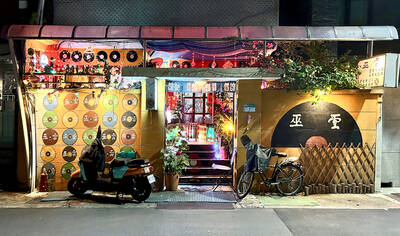
The Lee (李) family migrated to Taiwan in trickles many decades ago. Born in Myanmar, they are ethnically Chinese and their first language is Yunnanese, from China’s Yunnan Province. Today, they run a cozy little restaurant in Taipei’s student stomping ground, near National Taiwan University (NTU), serving up a daily pre-selected menu that pays homage to their blended Yunnan-Burmese heritage, where lemongrass and curry leaves sit beside century egg and pickled woodear mushrooms. Wu Yun (巫雲) is more akin to a family home that has set up tables and chairs and welcomed strangers to cozy up and share a meal
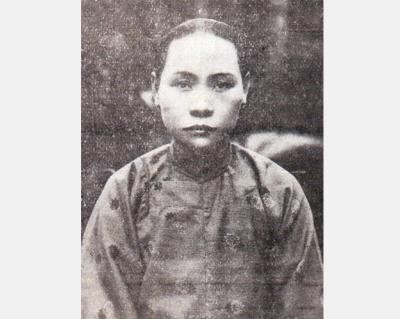
Dec. 8 to Dec. 14 Chang-Lee Te-ho (張李德和) had her father’s words etched into stone as her personal motto: “Even as a woman, you should master at least one art.” She went on to excel in seven — classical poetry, lyrical poetry, calligraphy, painting, music, chess and embroidery — and was also a respected educator, charity organizer and provincial assemblywoman. Among her many monikers was “Poetry Mother” (詩媽). While her father Lee Chao-yuan’s (李昭元) phrasing reflected the social norms of the 1890s, it was relatively progressive for the time. He personally taught Chang-Lee the Chinese classics until she entered public

Last week writer Wei Lingling (魏玲靈) unloaded a remarkably conventional pro-China column in the Wall Street Journal (“From Bush’s Rebuke to Trump’s Whisper: Navigating a Geopolitical Flashpoint,” Dec 2, 2025). Wei alleged that in a phone call, US President Donald Trump advised Japanese Prime Minister Sanae Takaichi not to provoke the People’s Republic of China (PRC) over Taiwan. Wei’s claim was categorically denied by Japanese government sources. Trump’s call to Takaichi, Wei said, was just like the moment in 2003 when former US president George Bush stood next to former Chinese premier Wen Jia-bao (溫家寶) and criticized former president Chen

President William Lai (賴清德) has proposed a NT$1.25 trillion (US$40 billion) special eight-year budget that intends to bolster Taiwan’s national defense, with a “T-Dome” plan to create “an unassailable Taiwan, safeguarded by innovation and technology” as its centerpiece. This is an interesting test for the Chinese Nationalist Party (KMT), and how they handle it will likely provide some answers as to where the party currently stands. Naturally, the Lai administration and his Democratic Progressive Party (DPP) are for it, as are the Americans. The Chinese Communist Party (CCP) is not. The interests and agendas of those three are clear, but